INTRODUCTION
Never has a country so large changed so much in such a short period of time. A hundred years ago China was a feudal country ruled by a child emperor, his evil grandmother and a court full of eunuchs. Sixty years ago it was an anarchic federation of feuding warlords who set the stage for the world's largest peasant uprising and Communist revolution. And 40 years ago, it was an isolated state dominated by slogan-chanting, book-burning, temple-destroying radicals.
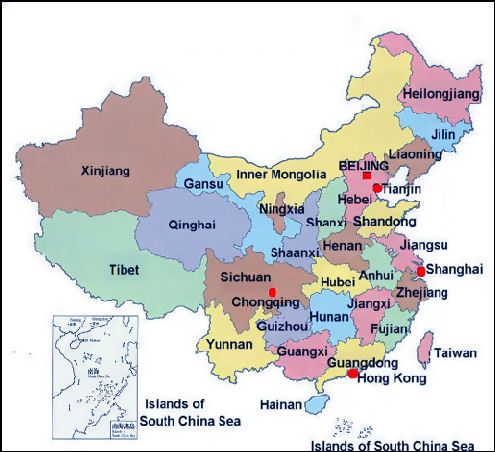
China's provinces
And the change continues at an astounding pace. Look at China now: a nation up of self-possessed capitalists who seem to have only two things on their mind: making money and ruling the world economically. Napoleon once said, "Let China sleep, when she awakes the world will be sorry." Since the mid 1980s, China has awaken with a vengeance.
The seeds for today's changes were sewn ironically enough by Mao Zedong, the pioneering Communist who fomented revolution in the countryside rather than the cities, and created the world's largest Communist state after World War II. Although Mao's leadership was marked by repression and grand but tragically inept schemes he is credited with unifying China and making the Chinese masses a part of society in a way that had never occurred before.
After Mao's death, one of the world's smallest leaders, Deng Xiaoping, maneuvered into power after being rescued from political purgatory. Eschewing Communist ideology but retaining authoritarian rule, Deng established pragmatic economic reforms that transformed China into a market-oriented economy governed by Communist leadership.
By the time Deng died in 1997, the reforms had become entrenched and sophisticated, and China had opened up to the outside world and government had even liberalized a bit. Images of brutal crackdowns at Tiananmen Square in 1989 and in Tibet became fuzzier as some political prisoners were set free, Chinese leaders attended lavish parties with Western leaders and some corrupt Communist were punished.
Travelers who venture to China today find it hard to believe that China was once a Maoist state. The cities are dominated by modern highrise office complexes, fast-food joints, and Western fashions. Rural areas feature lively markets, souvenir-selling villagers and family-held plots of land. The one place where the Communist party seems to be making its last stand is in media: newspapers seem locked in a Soviet-style time capsules and television programming is a procession of party meeting, factory tours and happy peasants.
In any case, change has happened so fast in China that many of its most attractive features have disappeared or been commandeered by the government to make money. Colorful hill tribes are displayed like trick-performing zoo animals, top-draw tourist attractions charge steep admission prices and temples, destroyed during the Cultural Revolution in the 1970s, have been hastily restored into kitschy replicas of the original. Who knows, ten years from now China could be Singapore with 1.3 billion people.
China now draws more foreign visitors than all but a few countries, most of them following a well-worn travel circuit that includes sights like the Great Wall of China, the terra-cotta army of Xian and the karst scenery around Guilin. The good news is that these places are still something to behold, they can be visited independently and they feature cheap accommodation, good restaurants and English-speaking guides. The bad news is that the sights are sometimes located in horrid, dirty Chinese cities and there are so many tourists they have a Disneyesque quality.
Although parts of China will no doubt become monstrosities beyond the limits of most travelers, the nation as a whole is so large and diverse that there will always be unspoiled places where Western people have never been and people live as their ancestors did 500 years ago. There are still many great adventures left in China. Every year more off-limit areas are opened up to foreign travelers and all you need to reach them is of few months and the toughness to endure long rides in uncomfortable trucks and buses.
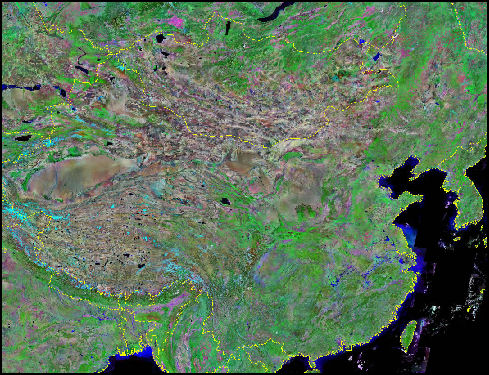
Satellite image of China
GEOGRAPHY
China is the third largest country in the world, after Russia and Canada. Covering 3,690,100 square miles, it is slightly larger than the United States including Alaska. Most of China's population lives in the relatively flat and fertile southeastern third of the country.
Only 15 percent of the country is good for agriculture (compared to 21 percent in the U.S.) and most of this land is on the central eastern coast and along around the Yangtze and Yellow river valleys. About 34 percent of China is covered by pastures, and 14 percent by forests. Mountains cover 58 percent of China. Deserts cover 28 percent. Plains and basisn cover around 35 percent.
China is made up of 21 provinces (such as Sichuan, Hunan and Guangdong) and five autonomous regions (Inner Mongolia, Ningxia, Xinjiang, Guangxi and Tibet) populated by large numbers of ethnic minorities. China's three largest cities — Beijing, Shanghai and Tianjin — are governed directly by the Chinese government.
Even though China is the world's most populous country, much of its land is uninhabitable or near uninhabitable. The western half of the country is mostly desert. The central and southern portion of the country is covered with rugged mountains and the northeast is heavily forested and bitterly cold in the winter. China also embraces rain forests, fog-shrouded coasts, evergreen forests, misty green mountains, vulnerable flood plains and vast steppes.
China has 32,000 kilometers of coastline and land border stretching for 22,000 kilometer (14,900 miles). It is bordered by more countries (15) than any other country: North Korea, Russia, Mongolia, Kazakstan, Kyrgyzstan, Tajikstan, Afghanistan, Pakistan, India, Nepal, Bhutan, Sikkim, Myanmar (Burma), Laos and Vietnam. The Yellow Sea lies between the east coast of China and the Korean peninsula. Further south is the East China Sea. Off the southern coast of China is the South China Sea. there is about 4,3000 miles of cost;ine. China measures about 3,000 miles form east to west (about the same as the United States) and 2,500 miles from north to south.
Northern China : The northern part of China proper is relatively flat and embraces the the Hwang Ho basin, the Qinling range, the Shanxi loess region, North Central Plain, Mongolia plateau, eastern highlands and central plain of Manchuria.
Much of China's northern border is shared with Russia. There were border skirmishes here in the 1960s and 1970s that lead to several hundred deaths. The tensions subsided after the break-up of the Soviet Union and the signing of a border agreement in 1997. Between Russia and China is Mongolia, a former puppet state of the Soviet Union that acted like a buffer between the two rival Communist nations. Mongolia is now free of Russian domination. China and Mongolia are both home to millions of ethnic Mongolians and they share the Gobi desert, a vast area of windy, grassy plains.

Sand dunes in Xinjiang
Western China : The western part of China is the home of the Tarim Basin and Taklimakan Desert, two of the driest and most desolate regions in the world, and the Tian Shan mountains. The Muslim ethnic groups that live here are similar to those found in the former Soviet Republics of Kazakstan, Kyrgyzstan, and Tajikstan. Many of the ethnic groups in western China are not particularly fond of the Beijing government or Han Chinese. There is even some talk that the Chinese territory of Xinjiang and Kyrgyzstan would like to become one country.
Southwest China : Mountainous southwest China borders the two rivalling countries of Pakistan and India. China is friendly with Pakistan (the two nations built the incredible Karakoram Highway together) but not India. In the 1960s, China and India fought a war over a inhospitable part of the Himalayas and the border in the area is still disputed. It is not possible to enter China from India.
The spine of the Himalayas, including Mount Everest runs along the border between Tibet (part of China) and Nepal.Most of Tibet is occupied by the Tibetan Plateau, a dry, desolate region, punctuated by mountains and isolated lakes. The average elevation in Tibet is 14,000 feet; roads routinely pass over 16,000- to 17,000-foot passes; and there are 40 peaks over 22,000 feet high. Very few people live in Tibet. The Tibetan plateau embraces the Himalayas, Kunlun Mountains and the Tahseh Shan.
Central China : The central part of China proper embraces the Yangtze Basin, Sichuan Basin and the Yangtze plains and delta. Between Tibet and the plains of eastern China are rugged, difficult-to- traverse ridges of mountains, many of them in western Sichuan. Getting across these mountains can take weeks. East of these mountain is the Yangtze River valley and the plains of northern and eastern China. This area is the heavily- populated home of the Han Chinese. It is also largely agricultural and has four seasons.
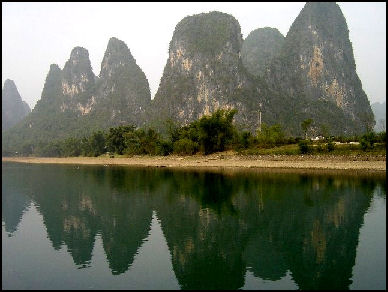
Guilin area of southern China
Southeast China is a green, semitropical region inhabited by large numbers of ethnic minorities similar to the hill tribes found in neighboring Burma, Laos and Vietnam. There are numerous mountains and mountain ranges of various sizes. Large tracts of forest have been cleared here and deforestation-induced erosion is very noticeable. The southern part of China proper embraces the Yunnan-Guizhou Plateau, the Tung, Pi and Si river valleys, the Southeast coastal uplands and Gungdong-Guangxi Hills.
Major Rivers : Rivers have traditionally been important transportation routes in Chinese. The Yangtze River (the third longest river in the world after the Nile and the Amazon), the Yellow River (the second largest river in China) and the Mekong River all begin in eastern Tibet and twist and turn through rugged mountains before reaching elevations low enough for of them to become navigable.
The Yangtze empties into the East China Sea near Shanghai and has traditionally divided China into north and south. The Yellow river takes a more northern route and empties into the Yellow Sea southeast of Beijing. Other important Chinese rivers include the Pearl River (near Hong Kong), Heilong River, Haiho River, Huaiho River and Yalu Tsango River.
Major Cities (estimated populations in 2008): Beijing (capital), 17.2 million; Shanghai, 18 million; Tianjin, 13 million; Guangzhou (Canton), 11.2 million; Chengdu, 10.2 million; Shenyang, 9 million. More than 100 cities in China have a population of more than 1 million.
See Separate Article LAND AND GEOGRAPHY OF CHINA factsanddetails.com

Precipitation map
CLIMATE AND WEATHER
China is a big country and the climate varies greatly from region to region. There are places with bitterly cold winters as well as ones with scorching summers and everything in between. Beijing and Shanghai and most of China are very hot and humid in the summer; climate differences are more variable on the winter.
Generally, southern China is relatively wet and northern China is largely dry. Rains tend to fall heaviest near the coasts and in the south and where mountains lift clouds pushed in by southeastern winds. South of the Yangtze River rainfall generally varies between 40 and 75 inches a year. North of the Yangtze rains diminish from 25 inches to 10 inches as one travels north. Rain also diminishes towards the west. In the Gobi Desert in Inner Mongolia and the Tarim Basin in Xinjiang the annual rainfall is less than four inches in many places.
The prevailing winds blow across southern China from the southeast. Further north they blow in from the west. Cold air pours down from Siberia in the winter. Warm air comes up from Southeast Asia and the South China Sea. There are often vicious storms, heavy rains, floods and landslides in the early summer.
Seasonal monsoon winds do not influence China as much as other Asian countries. However the early summer is the peak rainy season in much of China. Seasonal rain fall is often unpredictable, resulting in droughts and floods. Cyclonic storms sometimes approach from Europe. Typhoons strike from time to time, particularly along the southeast coast, in late summer and early fall.
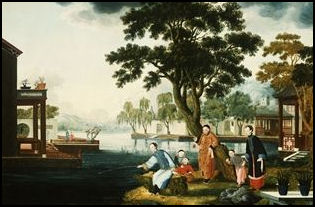
Summer weather scene
Southern China is a semitropical region with lots of rain, a mild winter (December, January, February), and a hot and humid summer that extends from May to September. The best times to visit are in the fall (October, November) and to a lesser extent in the spring (March, April). The spring is often hazy and rainy, whereas the fall often features clear blue skies with puffy clouds.
The temperatures are generally cooler in the highlands and along the coast. In the summer, the humidity is high, often 90 percent or more, and high temperatures are usually around 90 degrees F. The temperatures can sometimes drop into the 40s at night in the winter, spring and autumn. Snow falls on the higher mountains.
Southern China is affected most by the monsoon season, which is known to Chinese as the "plum rain season" and is dominated by the Bai-u front In most places the monsoon season extends from June to September . In some places it begin in May. The Bai-u front brings seasonally heavy rains in June and July. The typhoon season is from July to October. The typhoons that strike southern China come in from the Pacific and South China Sea and are usually characterized more by their heavy rains than high winds.
Autumn is often the best time of the year ro visit southern China. In November the highs around 25 degrees C and the lows are around 15 degrees C, which is freezing to many people in the south, The skies are generally clear. There is less humidity and rain than in the spring
Central and Northern China has four seasons, and the climate is comparable to that of the eastern United States, with the lengths and intensity of the winters and summers varying with the latitude and proximity to the sea. Spring is pleasant, sunny and mild. Summer, arriving in June and often accompanied by month-long rainy season, is characterized by hot, humid weather. The winters tend to be cold and dry. There is snow in many places.
The fall is the nicest time of the year in northern China. The days are often clear; the air is brisk and bracing; the temperatures are cool and there are pretty autumn colors. The spring — especially in Inner Mongolia, Gansu and Shanxi and areas upwind from Beijing — is often very windy, with some intense dust storms that fill the air with chocking grit and turn the sky orange.
Beijing : Beijing has cold winters, hot summers and windy and dusty springs. Autumn is the nicest time of the year. In the winter canals and lakes freeze over and snow sometimes falls. The marginal rainy season begins in June. August is the rainiest month. The average high in August is 29 degrees and the average rainfall is less than 17 centimeters. Many people feel the humidity is worse than the pollution or the heat. Tracee Hamilton wrote in the Washington Post, “Everything here is damp. Hand washed clothes never dry. A packages of Ritz cracker opened at 8 a.m...is stale by 11 and inedible by 4.”
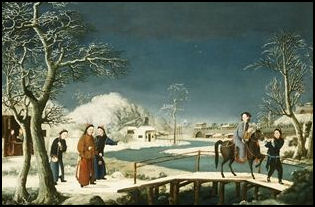
Winter weather scene
Northwest China is very dry, with many places receiving less than four inches of rain a year. Many of the towns and cities have grown up around oases. The summers tend to be scorching and dry with chilly nights and daytime high temperatures that often exceed 110 degrees F. In some ways the summers are more bearable in the northwest China than elsewhere in China because the humidity is low and the early mornings are relatively cool. The winters are bitterly cold with temperatures often dropping below 0 degrees F. Spring and autumn are relatively short but pleasant except when fierce dust storms blow up in the spring.
Tibet has a harsh climate. The temperatures frequently drop below minus 30 degrees F in the winter and rise above 100 degrees F in the summer, with temperature sometimes fluctuating 80 degrees F in a single day. But generally Tibet is cool or cold and people walk around bundled up in many layers of clothes. It is no surprise that many Tibetans believe that hell is a bitterly cold place not an inferno.
There is very little water in Tibet. Snow frequently falls but rarely accumulates, and the climate is so dry that grain can be stored for 50 years. The extremes of hot and cold, coupled with the thin air and high altitude sunshine, are enough to break granite mountains into sand, and generate fierce winds, stinging hailstorms, and blinding dust storms.
See Separate Article CLIMATE OF CHINA: PRECIPITATION, REGIONAL AND SEASONAL VARIATIONS factsanddetails.com ; China Meteorological Administration cma.gov.cn
Best Times to Visit
Best Times to Visit are in the autumn. The winters are cold and the summers can be hot and humid. Prices are high in the summer too. Spring is cloudy and hazy in the south and windy and still cold in the north. The main holiday seasons for Chinese are: 1) around Chinese New Year in early February; 2) Labor Day holiday week in the first week of May; and 3) the National Day week off in early October. These are bad times, especially during Chinese New Year, to try and get anywhere. All means of transportation are hopelessly overcrowded. The main holiday season for foreign visitors is during the summer holiday in July and August. Some tourist spots have high season and low season (early November to late March) hours and prices.
Clothing
Most clothing styles are acceptable. Some Chinese dress smartly and fashionably. Most dress in drab, nondescript slacks, shirts and jackets. Wearing shorts and jeans is okay, but don't wear clothes with holes. Dirty or shabby clothing is sometimes interpreted as an expression of disrespect. Even though you see men in without shirts and people wearing their pajamas to the market don’t imitate these styles You can wear ordinary clothes to the Peking opera.
Women in shorts skirts, jeans or tights and men in short pants and informal clothes are common in the cities but may offend some people in the countryside. Keep in mind also that shorts, exposed shoulders and short skirts are may be regarded unacceptable in some temples.
In hot weather, wear loose cotton garments, a hat and sunglasses and use sun screen for protection from the sun.. Don’t wear synthetic fabrics; they can be hot and scratchy. White or light-colored garments are better than dark ones. Sandals are often more comfortable than shoes and easier to slip on and off when entering temples.
Layers of clothing are recommended in the spring and autumn to adapt to temperature changes throughout the day. Make sure you have a jacket for the cool nights. Bring warm clothes if you are arriving in the winter. People planning to do any bicycling, hiking or traveling in the rainy weather are advised to bring long underwear, fleece outer garments and rain gear, preferably made with Gortex.
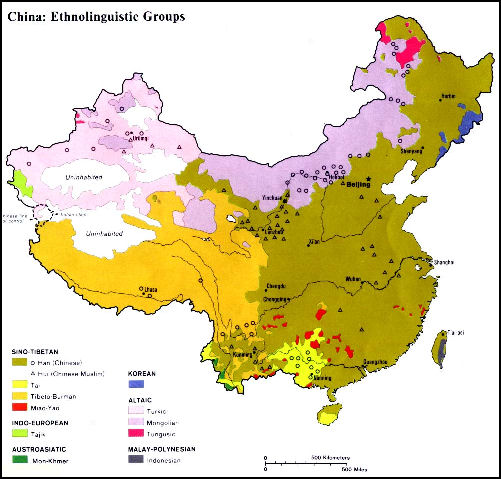
PEOPLE
China is the world's most populous country, with about 1.32 billion people (estimated 2007). It's closest rival, India, has around 1 billion people but is expected to have more people than China by the year 2030 as a result of having a less successful family planning policy than China.
More than 44 percent of all Chinese live in urban areas (compared to 76 percent in the U.S.); the population is only growing at the rate of 0.6 percent a year (compared to -.2 percent in Britain and 3.0 percent in Kenya); and the average life expectancy is 70 for men and 74 for women. About 24 percent of all Chinese are under 15, and 7.3 percent are over 65.
The Han Chinese — the ethnic group that embraces Mandarin-, Shanghai- and Cantonese-speaking Chinese — make up 92 percent people of the population, which adds up to over one billion people. The Han Chinese hail from China's Northeast Plain and the Yangtze, and Yellow River valleys. Today they are scattered all over the country and many non-Han Chinese feel that their homelands are being overrun by them. Han Chinese also make most of the population of Taiwan and Singapore and most of the Chinese found elsewhere in the world.
The remainder of China's population is comprised of 55 other ethnic groups. Although they make up only 8 percent of the population, these ethnic minorities still add up to 91 million people, which is a larger population than all but ten countries in the world. These minorities occupy 64 percent of China's land, much of it remote and sparsely populated. Many minorities live in compact communities at the upper reaches of large rivers and in border regions. Much of the land they occupy, such as Xinjiang, is rich in minerals, oil and other resources.
There are 18 ethnic groups with over a million people. They include Tibetans, Mongolians, Uygurs, Zhuang, Manchus and Koreans. The smallest ethnic, the Lhoba, has only about 2,300 members. Many of the ethnic groups still dress in traditional clothes and some of them have some very unusual customs. See Minorities.

LANGUAGE
Chinese is the official language of China. It is the world's most widely spoken language — the first tongue of 950 million people — and is the native language of the Han people. Mandarin, Shainghaiese, Cantonese and Sichuan are all regarded as dialects of Chinese although some linguists categorize them as distinct languages. There are six major Chinese dialects and several dozen minor dialects and sub-dialects. The majority of China’s 55 minorities have there own languages, and 21 of them have their own written languages.
Mandarin, the most widely spoken dialect, is spoken by 70 percent of the population and is the first language of Han Chinese from Beijing, the northeast and southwest. Mandarin is a term used by Europeans to describe Chinese scholars and the dialect gets its name from the fact that the Beijing dialect was the one most widely spoken by the scholar class in Beijing, China's capital of the home of the emperor and his bureaucracy of scholars. Cantonese, another widely-spoken dialect, is spoken in Hong Kong, Guangdong and southern Guangxi.
Chinese is a hard language to master. The grammar is relatively easy and similar to the grammar of English but the pronunciation is difficult for non-Chinese. Chinese is a tonal language, which means that the meaning of the word can change with the tone or pitch in which it is spoken. The Cantonese word for "apple," for example, is uttered in 'C sharp.' If it is intoned in 'A' it means "German shepherd."
Mandarin is "flat timbre" language with just four tones (high, rising, falling-rising and falling) and consonants that have no equivalent in Cantonese. Cantonese has nine tones, features numerous colloquial expressions and has an earthy "din" sound that often sounds like shouting.
The Chinese language is one of the biggest obstacles to overcome when traveling in China because not so many people speak English. The tonal nature of Chinese pronunciation means is it is difficult to make yourself understood even you when read something from a phrase book, which often are difficult to decipher in themselves. When buying train or bus tickets or giving instruction to taxi drivers it is a good idea to have everything written down. You can either copy the Chinese characters from a guide book or phrase book or get a Chinese person to write them for you.
English is not widely spoken in China and most train, road and shop signs are written only in Chinese characters. Chinese people involved in the tourist industry — guides and hotel and restaurant employee — often speak rudimentary English but are often not fluent in the language. Off the beaten track virtually no one speaks English other than "Hello." More people are leaning English all the time and those who speak it well enough to engage in a conversation relish the opportunity to speak it with native English speakers. Many cities have English corners where Chinese gather to speak English with one another and with foreigners.
Written Chinese is usually comprised of words with two or more characters. Linguists count around 56,000 characters but most of them are obsolete. Most Chinese know about 8,000 characters. Knowledge of around 1,200 to 1,500 characters is generally enough to understand most of what is written in a newspaper article.
Linguists divide Chinese characters into six groups: pictograms (stylized pictures of objects); ideograms (abstract pictures); compound ideograms (combination of ideograms to represent an idea or object); phonograms (characters with a meaning element and a phonetic elements); and other infrequently used characters (such as phonetic loan and derivative loan characters). About 90 percent of all Chinese characters are phonograms.
Introduced in 1954 and based on Beijing pronunciation, the Chinese Phonetic Alphabet System (Pinyin) is used for turning Chinese names and places into names and places written in the Roman alphabet. "Beijing," Mao Zedong" and "Zhou Enlai" are examples of Pinyin. "Peking," "Mao tse tung" and "Chou en-lai" were written with the old Wade-Giles spelling system which has been abandoned. Don't bother with a Chinese-to-English dictionary. It takes at least six months of studying Chinese be able to look up words characters in a dictionary.
Learning Chinese : If you want to learn or practice a Chinese language you can hire a tutor, enroll in a private language school or take a class through a university, community college or local recreation program. There are lots of books and web sites. See Studying Abroad, Activities
RELIGION
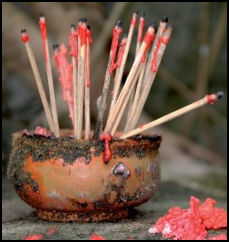
joss sticks
Officially China is an atheist country but spiritual beliefs and superstitions still play a big part in the lives of most Chinese. The Chinese recognize both Buddhist and Taoist deities as well as ancestral spirits in hope of making all spirits and gods happy and thus ensuring good fortune.
Confucianism is regarded as an important religion but it is not really a religion but a philosophy and moral code that incorporates ancestor worship as one of its beliefs. Some Chinese go to temples regularly and many consult fortune tellers about important decisions. The economic reforms of the Deng era have been accompanied by some liberalizations towards religion but many religious groups such as Christians, Muslims, and Tibetan Buddhists continue to be oppressed.
Image Sources: 1) CNTO (China National Tourist Organization; 2) Nolls China Web site; 4) Dartmouth College; 5) tourist and government offices linked with the place shown; 6) University of Washington, Purdue University, Ohio State University; 7) NASA
Text Sources: CNTO, New York Times, Washington Post, Los Angeles Times, Times of London, National Geographic, The New Yorker, Time, Newsweek, Reuters, AP, Lonely Planet Guides, Compton’s Encyclopedia and various books and other publications.
